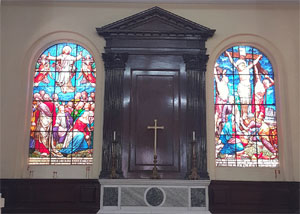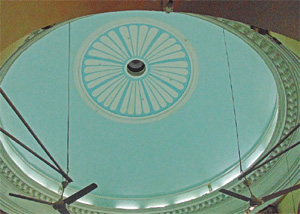Various legends and stories are related regarding the construction of the church by James’ Skinner. The most popular of them is that Skinner made an oath and promised God that he would construct a Church if he returned alive from the battle field at Uniara, where he lay badly wounded in 1800. God answered his prayers and Skinner survived the battle and to keep his promise, he had the church constructed.
The architect of the church was Major Robert Smith, an army engineer. The construction of the church commenced in 1826 and it was completed in 1836. The church was consecrated on the 21st of November 1836, by Daniel Wilson, the Bishop of Calcutta. James’ Skinner died at Hansi on 4th December 1841. Though he was initially buried there, later his remains were brought to Delhi, and interred within the church on 19th January 1842.
Subsequent history of the church
- In the early years, one event particularly had a wider significance, was the baptism of Master Ram Chandra – the mathematics teacher at the Delhi College, and Dr.ChimmanLal in 1852. This happened during the devoted ministry of Midgley John Jennings, who is remembered not only for his guidance of the St. James’ flock, but for his invaluable service in making Delhi, a centre of Christian work.
- In 1854 St. James’ welcomed the first representative of the Society for the Propagation of the Gospel, London. It was the beginning of the work which led, in the years that followed, to the development of the young Church in Delhi. The First members of the Cambridge Brotherhood arrived in Delhi in 1877. Right from the early days St. James’ maintained close links with the members of the Brotherhood
- During the Revolt of 1857, the church was attacked, and considerable damage was done to it.
- In 1911, when King George V’s proclamation at the Delhi Durbar, restored to the city its status of the imperial capital, St. James’ Church became the semi-official church of the Government of India and the Army Headquarters. It retained this position until the consecration of The Church of the Redemption in New Delhi in 1931.
- In 1936, when St. James’ Church celebrated its centenary, Christopher Robinson, a member of the Cambridge Brotherhood, was the Chaplain. He was the moving spirit behind the Parish Homes and the Parish Hall, both built in course of the centenary celebrations. The Parish hall, designed by the architect Walter George, is a single storey building that has an arched verandah with small square rooms at either end and a large double-height hall at the rear end.
- Also in the centenary year of the church, Robert Skinner, a grandson of James’ Skinner, announced a gift for building a chapel in the church. This chapel, dedicated to the Blessed Virgin Mary, was consecrated in 1938, at the same time as the church sacristy was dedicated. Incidentally, in fulfilment of his own wish, the mortal remains of Robert Skinner were laid to rest in the Chapel in 1945.
- In 1942 when Chaplain Christopher Robinson left St. James’ Church, his successor was designated Chaplain of Delhi and Vicar of St. James’- pointing to the changes that were setting in.
- April 1946 and again at Palm Sunday of 1952 saw Dr. Stanley Jones, one of the most able and powerful Christian evangelists in India of his time, gave an address in the Parish Hall
- In 1961 Her Majesty Queen Elizabeth II of Great Britain and Prince Philip, Duke of Edinburgh, worshipped in the Church on January 29th. Click here to see the entry in the Church visitor book).
- In 1970 the church boundary wall was taken up for rebuilding, as over the years the old wall had been systematically damaged from outside, for the value of the iron spikes that the masonry contained.


